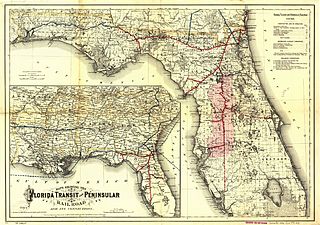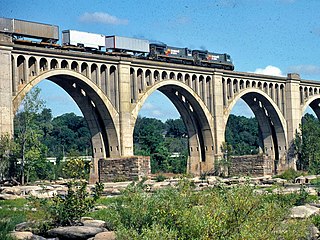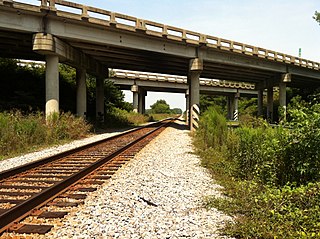
The Florida Central and Peninsular Railroad was the final name of a system of railroads throughout Florida, becoming part of the Seaboard Air Line Railway in 1900. The system, including some of the first railroads in Florida, stretched from Jacksonville west through Tallahassee and south to Tampa. Much of the FC&P network is still in service under the ownership of CSX Transportation.
The Wilmington and Weldon Railroad (W&W) name began use in 1855, having been originally chartered as the Wilmington and Raleigh Railroad in 1834. When it opened in 1840, the line was the longest railroad in the world with 161.5 miles (259.9 km) of track. It was constructed in 4 ft 8 in gauge. At its terminus in Weldon, North Carolina, it connected with the Seaboard and Roanoke Railroad and the Petersburg Railroad. The railroad also gave rise to the city of Goldsboro, North Carolina, the midpoint of the W&W RR and the railroad intersection with the North Carolina Railroad. It’s been more than 50 years since passenger rail linked Wilmington and Raleigh, but there’s a renewed push to bring back a passenger route between the two cities. The latest feasibility study, prepared by Florida-based firm WGI Inc., compares two potential route options linking Wilmington with Raleigh: a western route through Fayetteville and an eastern route through Goldsboro.
The Raleigh and Gaston Railroad was a Raleigh, North Carolina, based railroad opened in April 1840 between Raleigh and the town of Gaston, North Carolina, on the Roanoke River. It was North Carolina's second railroad. The length was 100 miles (160 km) and built with 4 ft 8 in gauge. Part of the Raleigh and Gaston's tracks remains in service today as part of CSX's S Line as the Norlina Subdivision of CSX's Florence Division.
The Northeastern Railroad was a 103-mile (166 km) 5 ft gauge railroad that served South Carolina in the second half of the 19th century.
The Wilmington and Manchester Railroad was a railroad that served South Carolina and North Carolina before, during and after the American Civil War. It received its charter in 1846 and began operation in 1853 from Wilmington, North Carolina, extending west to the now-defunct town of Manchester, South Carolina. The track gauge was 5 ft.
The Cape Fear and Yadkin Valley Railway was a Southeastern railroad that operated in the Carolinas immediately after Reconstruction. It ran from Mount Airy, North Carolina, southeast through Greensboro and Fayetteville to the Atlantic port of Wilmington, North Carolina. A significant branch also ran from Fayetteville south to Bennettsville, South Carolina.
The Central Railroad of South Carolina was a South Carolina railroad that operated following Reconstruction. It ran between the town of Lane and Sumter, a distance of about 40 miles (64 km). The line is in service today as CSX's Lane Subdivision.
The Monroe Subdivision is a railroad line owned by CSX Transportation in the U.S. states of North Carolina and South Carolina. The line runs from Pee Dee, North Carolina to Abbeville, South Carolina, for a total of 177 miles. The full line is dispatched by Centralized traffic control.

The North End Subdivision is a railroad line owned by CSX Transportation in Virginia and North Carolina. The line runs from Richmond, Virginia, to Rocky Mount, North Carolina, for a total of 123.2 miles. At its north end the line continues south from the Richmond Terminal Subdivision and at its south end the line continues south as the South End Subdivision. The North End Subdivision is the northernmost segment of CSX's A Line which in its entirety runs from Richmond to Tampa, Florida. Some of the line's notable features include running in the median of Interstate 195 in Richmond as well as the line's tall arch bridge over the James River.
The Portsmouth Subdivision is a railroad line owned by CSX Transportation in Virginia and North Carolina. The line connects CSX's network with the port city of Portsmouth, Virginia. The Portsmouth Subdivision was historically operated by the Seaboard Air Line Railroad, a CSX predecessor.

The South End Subdivision is a railroad line owned by CSX Transportation in the U.S. states of North Carolina and South Carolina. The line runs from Rocky Mount, North Carolina, to Florence, South Carolina, for a total of 172.8 miles (278.1 km). At its north end the line continues south from the North End Subdivision and at its south end the line continues south as the Charleston Subdivision. The South End Subdivision is a part of CSX's A Line, one of their mainline which ultimately extends from Richmond, Virginia to Tampa, Florida.
The W&W Subdivision is a railroad line owned by CSX Transportation in the U.S. state of North Carolina. The line today runs from just south of Wilson, North Carolina, to Wallace, North Carolina, for a total of 69.1 miles. At its north end the line connects to CSX's A Line. The line's name stands for the Wilmington and Weldon Railroad, the company that originally built the line.
The Waycross Short Line was the unofficial name of a railroad line built by Henry B. Plant that ran from Waycross, Georgia to Jacksonville, Florida on the St. Johns River. The line through Georgia was chartered by Plant as the Waycross and Florida Railroad and the Florida segment was chartered as the East Florida Railway. The line crossed the Georgia/Florida border just south of Folkston, Georgia at the St. Marys River.
The Folkston Cutoff is a railroad line in southern Georgia. It runs from Jesup southwest to Folkston, a distance of 54 miles. It was built in 1901 by the Plant System to allow trains from the northeast to Florida to bypass their busy terminal in Waycross.

The CSX A Line forms the backbone of the historic Atlantic Coast Line Railroad Main Line, the backbone of their network in the southeastern United States. The main line runs from Richmond, Virginia to Port Tampa just southwest of Tampa, Florida, a distance of nearly 900 miles. Along its route it passes through Petersburg, Rocky Mount, Florence, Charleston, Savannah, Jacksonville, and Orlando. With the exception of a short 61-mile segment in Greater Orlando, the entire line is owned by CSX Transportation.

The Carolina Central Railroad, was a railway company in the United States. It was incorporated in 1855 as the Wilmington and Charlotte Railroad and was renamed the Wilmington, Charlotte and Rutherford Railroad shortly after. It was reorganized as the Carolina Central Railway in 1873. It built 152 miles (245 km) of track, in two unconnected sections, in the southern part of North Carolina. The company was again reorganized as the Carolina Central Railroad in 1880. In 1900, the Carolina Central Railroad was merged into the Seaboard Air Line Railroad. Its lines are now owned by CSX Transportation.
The Seaboard Air Line Railroad's East Carolina Line was the unofficial name of their line running from Hamlet, North Carolina through eastern South Carolina to Savannah, Georgia. Officially designated on Seaboard employee timetables as the Andrews Subdivision from Hamlet to Andrews, South Carolina, and the Charleston Subdivision from Andrews south, the line was known as the East Carolina Line by Seaboard employees due to its location in eastern South Carolina. With connections to the Seaboard's main line at both ends, the East Carolina Line was frequently used as an alternative freight route for the company.
The Atlantic Coast Line Railroad's Wilmington—Pee Dee Line was a railroad line running from Wilmington, North Carolina west to Pee Dee, South Carolina. Running in an east–west trajectory, it notably passed through Lake Waccamaw, Chadbourn, Nichols, and Mullins. Some of the line is still operating today.
The Atlantic Coast Line Railroad's Parkton—Sumter Line was one of the company's secondary main lines running between Parkton, North Carolina and Sumter, South Carolina.
The Atlantic Coast Line Railroad's Kinston Branch was a railroad line that at its greatest extent ran from company's main line in Pender, North Carolina south to Kinston, North Carolina. The line south of Parmele, North Carolina is still active today and is now the Parmele Subdivision of CSX Transportation, the Atlantic Coast Line's successor company through various mergers.






